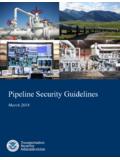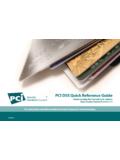Transcription of MIGRATION, AGRICULTURE AND CLIMATE CHANGE
1 1 Reducing vulnerabilities and enhancing resilienceMIGRATION, AGRICULTURE AND CLIMATE CHANGE2 PAGES 4 6 INTRODUCTION A growing and complex global phenomenon The global response translating commitments into action PAGES 7 9 migration , AGRICULTURE AND CLIMATE CHANGE A complex nexus PA G E S 10 11 migration AS A COPING AND ADAPTATION STRATEGY Opportunities and challenges Context-specific policy responses PAGES 12 19 FAO S CONTRIBUTION TO ADDRESSING migration CHALLENGES UNDER CLIMATE CHANGE Ensure food security of vulnerable populations at places of origin and destination Manage and use natural resources sustainably Support adaptation strategies that enhance inclusive rural development Enhance resilience to weather and CLIMATE extremes Integrate migration into CLIMATE CHANGE policies and strategies Promote collaborative actions to respond to CLIMATE -related drivers of migration Cover photo:Somalia A woman and her son walk in a camp for internally displaced persons on the outskirts of the village of Qardho, Somalia.
2 The pastoralists moved there after they lost their livelihoods due to drought. FAO/Karel PrinslooCONTENTSMIGRATION, AGRICULTURE AND CLIMATE CHANGE3 PAKISTAND aily life at an internally displaced persons camp set up for flood victims in Sukkur FAO/A s i m H a f e e z1 Distress migration refers to movements of people for whom migrating is perceived as the only viable option out of life at a camp in Muzaffargarh set up for internally displaced persons made homeless by flooding in Sukkur. FAO/A s i m H a f e e zKEY MESSAGESTHE CONTEXT OF migration , AGRICULTURE AND CLIMATE CHANGE CLIMATE CHANGE is a cause of rural migration and intensifies other socio-economic drivers of migration , such as rural poverty and food insecurity. Short- and long-term effects of CLIMATE CHANGE have significant impacts on agricultural productivity, rural livelihoods and, indirectly, migration flows.
3 CLIMATE CHANGE impact on migration is through increases in the frequency and intensity of weather and CLIMATE risks. These CLIMATE -related risks can be sudden-onset events ( tropical storms, heavy rains, floods and droughts) or slow-onset ones ( sea-level rise, salinization and desertification). migration in the context of CLIMATE CHANGE has multiple causes. The combination of CLIMATE -related risks with socio-economic drivers increases the vulnerability of AGRICULTURE , leads to loss of livelihoods and triggers migration . Internal migration is one of the coping strategies adopted in response to the threats of weather and CLIMATE extremes. Seasonal migrants, in particular, tend to return to their places of origin and rebuild their migration CHALLENGES AND OPPORTUNITIES UNDER CLIMATE CHANGE migration can be an adaptation strategy to CLIMATE CHANGE .
4 Safe, orderly and regular migration can contribute to AGRICULTURE development, economic growth, food security and rural livelihoods. Poorly managed migration can increase vulnerability to CLIMATE risks, heighten pressure on scarce natural resources, and exacerbate tensions between migrants and host communities on land tenure and resource rights. migration can increase the resilience of vulnerable populations, especially in CLIMATE -sensitive rural areas. Migrants can help create decent employment and inclusive social protection systems by transferring remittances, technology, knowledge and skills. Investing in sustainable AGRICULTURE should be central to the response to CLIMATE and migration challenges as it promotes the adaptation to and mitigation of CLIMATE CHANGE and also reduces other root causes of migration such as rural poverty and food insecurity.
5 Mainstreaming migration into CLIMATE CHANGE adaptation, disaster risk reduction policies and plans, and sustainable development is vital in order to effectively manage the challenges of migration and to fully harness its developmental , AGRICULTURE AND CLIMATE CHANGEA GROWING AND COMPLEX GLOBAL PHENOMENON migration is a growing and complex global phenomenon. CLIMATE CHANGE drivers and risks such as tropical cyclones, heavy rains and floods, droughts and desertification, and sea-level rise are among the causes of migration from rural areas. CLIMATE CHANGE is causing or contributing to an increase in the frequency and intensity of these events and their adverse migration , including migration in the context of CLIMATE CHANGE , has multiple causes. The convergence of climatic risks with other socio-economic stressors increases vulnerability and contributes to the loss of livelihoods.
6 This situation can trigger migration from rural areas. In developing countries, the AGRICULTURE sectors (crops and livestock, fisheries and aquaculture and forestry) absorb 26 percent of the total damage and losses from CLIMATE -related These impacts aggravate food insecurity and intensify migration around the world. Between 2008 and 2015, an average of million people were displaced annually by natural-hazard-induced and CLIMATE -related disasters and this trend is Today the total number of international migrants, including those displaced by CLIMATE -related natural disasters, is 40 percent higher than in 2000, with numbers expected to exceed 400 million by It is difficult to accurately estimate the number of migrants as a result of CLIMATE CHANGE . Given the complex drivers of migration , estimates of CLIMATE -related migration vary greatly.
7 This is due in part to a lack of data and the difficulty in isolating CLIMATE CHANGE as a driver of migration . Overall, migration associated with CLIMATE CHANGE is growing, and more likely to be in the form of internal mobility within a GLOBAL RESPONSE TRANSLATING COMMITMENTS INTO ACTIONG lobal agendas and frameworks recognize the positive contribution of migrants for CLIMATE risk reduction, resilience building, food security, poverty reduction and economic growth. The 2030 Agenda for Sustainable Development emphasizes the need for international cooperation to enable safe, orderly and regular migration and so ensure this positive contribution. Migrants driven by necessity rather than by choice will probably experience increased 1 FAO. 2017. The impact of disasters on AGRICULTURE : addressing the information gap. Rome. (also available at ).
8 2 IDMC & NRC (Internal Displacement Monitoring Centre and Norwegian Refugee Council). 2015. Global Estimates 2015: People displaced by disasters. Geneva. (also available at ).3 FAO. 2016. The future of food and AGRICULTURE trends and challenges. Rome. (also available at ). migration when a choice and not a necessity can play an important role as an adaptation strategy to CLIMATE CHANGE . INTRODUCTION 5 CLIMATE CHANGE , AGRICULTURE AND MIGRATIONFOOD SECURITY vulnerability as they are likely to have less adaptive capacity and ability to adjust or respond to the impacts of CLIMATE CHANGE . This can lead to maladaptation. Migrants contribute to inclusive growth and sustainable development of places of origin, transit and destination. To harness these development potentials, global commitments to address the root causes of CLIMATE - CHANGE -related migration need to be translated into actions.
9 The Sendai Framework for Disaster Risk Reduction, the Paris Agreement and the 2030 Agenda for Sustainable Development highlighted the need for urgent action to respond to CLIMATE CHANGE , and to address its role as a driver of migration . It is important to recognize that moving from commitment to action should ensure effective responses to CLIMATE CHANGE impacts without threatening food Sendai Framework for Disaster Risk Reduction (2015 2030)4 recognizes the importance of migrants and their contribution to the resilience of communities and societies, and that their knowledge, skills and capacities can be useful in the design and implementation of disaster risk reduction measures. It further points out that disaster risk reduction provides the international community with a unique opportunity to enhance coherence across policies and institutions for implementation.
10 4 UNISDR (United Nations Office for Disaster Reduction). 2015. Sendai Framework for Disaster Risk Reduction (2015 2030). Geneva, Switzerland. (also available at ).HAITIP eople queueing for distribution of seeds and tools in Casudre, 20 km north of Les Cayes. FAO/Giulio Napolitano6 The 2015 Paris Agreement5 called for developing recommendations for integrated approaches to avert, minimize and address displacement related to the adverse impacts of CLIMATE CHANGE . Through the Warsaw International Mechanisms for Loss and Damage, the Paris CLIMATE CHANGE Conference (COP 21, December 2015) established a Task Force on Displacement to develop such recommendations. The Task Force complements, draws upon and involves the work of existing bodies and expert groups under the United Nations Framework Convention on CLIMATE CHANGE , as well as relevant organizations and expert bodies outside the convention.















